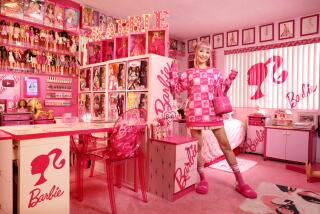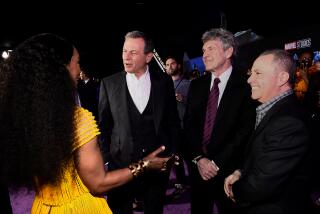This Toy Story Lacks Feminist Plot
- Share via
Two years ago, for a few moments on Christmas morning, I was delightfully deluded. As my 2-year-old unwrapped her Little Tikes Wee Waffle farm set, I imagined we were in an idyllic, prelapsarian toddler phase in which children’s toys were unisex. At least this year, I thought, there will be no battles over whether Barbie and her wardrobe will inhabit our house, no pop-psych deconstructions of the Little Mermaid trading her voice for a husband. We won’t debate whether Power Rangers provide badly needed female action heroes or equal opportunity violence.
It will be all Duplos, Play-Doh and Beanie Babies. But I was wrong. As we assembled the farm set, we found that the father plugged into a round hole in the driver’s seat of the tractor but the mother--literally a square peg in a round hole--didn’t. And so it began. Thirty years of feminism notwithstanding, the mass-market toy industry has either slept through the women’s movement or woefully misunderstood it.
Nowhere is this more apparent than at the annual American International Toy Fair, where gender apartheid flowers freely in a hothouse of go-go commerce: Girls get dolls, kitchen sets and makeup packaged in Pepto-Bismol pink; boys get weapons, action figures and vehicles in everything but pink. The color-coding starts at birth, and the role assignments kick in when children are still toddlers, barely able to keep their balance, much less process the demands of their gender. Like many parents before me, I decided that this was a simple issue of choice. My girl would get boys’ toys along with baby dolls.
But my solution was wrong. I’ve since discovered that if I encourage my 4-year-old daughter to cross-play, I push her into a world without women; a galaxy of “Star Wars” action figures in which the rare female--Princess Leia, for example--is lauded as “the essence of youthful exuberance and blossoming beauty.” (But she’s an action figure--what does she do?) I wasn’t sure this was a world to which equal access was desirable.
When I investigated the only commercial arena in which “boys’ ” toys are being aggressively marketed to girls--computer games--I found another kind of segregation. Here, girls are hustled into a pink ghetto of “girl games” where they remain a special-interest group, spoon-fed a familiar diet of fashion, ponies and crafts. I assumed any company hip enough to use the motto “for girls who aren’t afraid of a mouse” would give good content. I was wrong again.
So, with the exception of a few exemplary gender-neutral companies like Wild Planet and Broderbund, my daughter has had three options: traditional play in a world without men; boy play in an androcracy; or a girl ghetto of low-content computer games. Who’d have thought that gender divisions would be so rigid at the turn of the millennium--after the WNBA and Xena? Although progress is being made in upscale mail-order catalogs, where color coding is less rampant and girls model firefighter costumes, commercial retailers remain perversely retrograde.
Take the Nano Fighter, a boxing “virtual pet” offered last year by Playmates Toys, unveiled with a flourish of essentialist logic: “The product takes on the nurturing play pattern loved by girls and replaces it with the competitive play boys crave,” allowing “an almost limitless number of Nano Fighters to be connected together to create a massive elimination tournament.” And for girls? Baby dolls, fashion dolls and “Nanosalon.”
According to a recent survey by the Renfrew Center in Philadelphia, 90% of commercial toys and dolls for girls age 2 to 10 emphasize beauty, shopping and dating. Even if you’re a parent who, like me, isn’t squeamish about tea sets and dress-ups or even Barbie--in moderation--you have to ask, is that all there is?
More to Read
The biggest entertainment stories
Get our big stories about Hollywood, film, television, music, arts, culture and more right in your inbox as soon as they publish.
You may occasionally receive promotional content from the Los Angeles Times.










